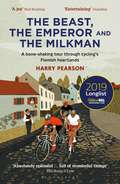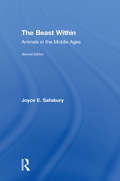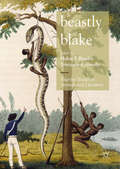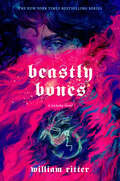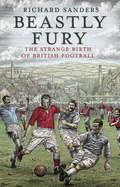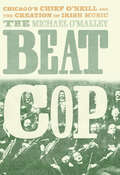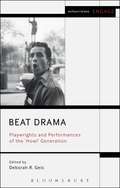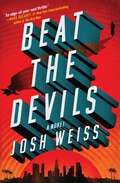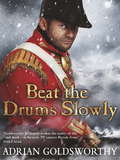- Table View
- List View
The Beast in the Jungle
by Louis BayardApril 1914. Former US President Theodore Roosevelt and his son Kermit have embarked on a dangerous expedition down an uncharted river in the Brazilian Amazon. Threatened as they are by disease, drowning and starvation, an even greater peril awaits them when they are captured by a local Indian tribe, the mysterious Cinta Larga, and forced to hunt for a savage creature laying waste to the jungle's inhabitants. In their search for the elusive beast, they find unexpected allies in a young mother and her half-caste child. But with hopes, dreams and lives at stake, father and son must confront the fissures in their own relationship and the dark secrets from their shared past. This exciting psychological thriller, inspired by actual historical events and figures, charts an audacious journey through the Amazonian heart of darkness and explores the demons that live within and without.
The Beast, the Emperor and the Milkman: A Bone-shaking Tour through Cycling’s Flemish Heartlands
by Harry PearsonCycling is wildly popular all over Belgium, but in the northern, Dutch-speaking half of the country it is part of the psyche. Flanders is the size of East Anglia with population a tenth of that of Great Britain, yet this small corner of north-west Europe has produced eight winners of the Tour de France, five times as many professional riders as Italy or Spain.Blending reportage, interviews, observation, biography and history and written with affectionate humour by a committed Belgophile, The Beast, the Emperor and the Milkman tells the story of Flanders' neurotic love affair with bike racing, from tough early heroes such as Jules Vanhevel – wounded by mortar fire in the First World War and leading the world championship road race until he collided with a cow – to latter-day ironmen such as Tom Boonen, three-times winner of the Tour of Flanders and owner of a pet donkey named Kamiel.
The Beast Within: Animals in the Middle Ages
by Joyce E. SalisburyPraise for the first edition: "...a brave and fascinating exploration of an area that has so far been rather neglected by both historical and literary critics. The Beast Within provides extremely valuable information on the legal and cultural background of the human-animal relationship..." -- Studies in the Age of Chaucer This important book offers a unique exploration of the use of and attitude towards animals from the 4th to the 14th centuries. The Beast Within explores the varying roles of animals as property, food and sexual objects, and the complex relationship that this created with the people and world around them. Joyce E. Salisbury takes an interdisciplinary approach to the subject, weaving a historical narrative that includes economic, legal, theological, literary and artistic sources. The book shows how by the end of the Middle Ages the lines between humans and animals had blurred completely, making us recognise the beast that lay within us all. This new edition has been brought right up to date with current scholarship, and includes a brand new chapter on animals on trial and animals as human companions, as well as expanded and updated discussions on fables and saints, and a new section on ‘bestial humans’. This important and provocative book remains a key work on the historical study of animals, as well as in the field of environmental history more generally, and also provides crucial context to ongoing debates on animal rights and the environment.
The Beast Within: Animals in the Middle Ages
by Joyce E. SalisburyPraise for the first edition: "...a brave and fascinating exploration of an area that has so far been rather neglected by both historical and literary critics. The Beast Within provides extremely valuable information on the legal and cultural background of the human-animal relationship..." -- Studies in the Age of Chaucer This important book offers a unique exploration of the use of and attitude towards animals from the 4th to the 14th centuries. The Beast Within explores the varying roles of animals as property, food and sexual objects, and the complex relationship that this created with the people and world around them. Joyce E. Salisbury takes an interdisciplinary approach to the subject, weaving a historical narrative that includes economic, legal, theological, literary and artistic sources. The book shows how by the end of the Middle Ages the lines between humans and animals had blurred completely, making us recognise the beast that lay within us all. This new edition has been brought right up to date with current scholarship, and includes a brand new chapter on animals on trial and animals as human companions, as well as expanded and updated discussions on fables and saints, and a new section on ‘bestial humans’. This important and provocative book remains a key work on the historical study of animals, as well as in the field of environmental history more generally, and also provides crucial context to ongoing debates on animal rights and the environment.
The Beast Within: Animals in the Middle Ages
by Joyce E. SalisburyThe third edition of The Beast Within has been updated throughout to include current scholarship, new discussion of definitions, and fresh perspectives on critical animal theory that places animals, rather than humans, at the center of the discourse. Organized thematically, Salisbury incorporates many new sections and subsections to reveal the multifaceted history of the relationship between humans and animals: domestication, animal diseases and pandemics, dogfights, cockfights, Islamic dietary restrictions, menageries and zoos, and animals as entertainers. To show how modern concerns have been informed by medieval precedents, sections have been expanded to uncover medieval understandings of animal sexuality, animals before the law, and vegetarianism and modern ‘fake meat’. The logical narrative concludes with chapters on ‘Animals as Humans’ and ‘Humans as Animals’, demonstrating that the lines between humans and animals have become increasingly blurred from the fourth to the twenty-first century. With an interdisciplinary approach that discusses humans and animals in relation to domestication, symbolism, science, law, religion, food and diet, sexuality, and entertainment, The Beast Within is an essential resource for all students of animal history, literature, and art in the Middle Ages.
The Beast Within: Animals in the Middle Ages
by Joyce E. SalisburyThe third edition of The Beast Within has been updated throughout to include current scholarship, new discussion of definitions, and fresh perspectives on critical animal theory that places animals, rather than humans, at the center of the discourse. Organized thematically, Salisbury incorporates many new sections and subsections to reveal the multifaceted history of the relationship between humans and animals: domestication, animal diseases and pandemics, dogfights, cockfights, Islamic dietary restrictions, menageries and zoos, and animals as entertainers. To show how modern concerns have been informed by medieval precedents, sections have been expanded to uncover medieval understandings of animal sexuality, animals before the law, and vegetarianism and modern ‘fake meat’. The logical narrative concludes with chapters on ‘Animals as Humans’ and ‘Humans as Animals’, demonstrating that the lines between humans and animals have become increasingly blurred from the fourth to the twenty-first century. With an interdisciplinary approach that discusses humans and animals in relation to domestication, symbolism, science, law, religion, food and diet, sexuality, and entertainment, The Beast Within is an essential resource for all students of animal history, literature, and art in the Middle Ages.
The Beastly Battles Of Old England: The misguided manoeuvres of the British at war
by Nigel CawthorneThroughout history the English have been a warlike lot. Often we fight among ourselves - there have been a good few civil wars - and when we were not slaughtering each other, we practiced on our neighbours, the Scots, the Irish, the French . . . When that got too easy, we set off around the world to find other people to fight. This was usually done with a hubris that invited some ludicrous pratfall. In THE BEASTLY BATTLES OF OLD ENGLAND, Nigel Cawthorne takes us on a darkly humorous journey through some of our ill-advised military actions. From the war over a severed ear to a general seeking out his rival's mistresses to even the score, it is a miscellany of insufferable arrogance, reckless gallantry, stunning stupidity, massive misjudgements and general beastliness.
Beastly Blake (Palgrave Studies in Animals and Literature)
by Helen P. Bruder Tristanne ConnollyBlake’s ‘Human Form Divine’ has long commanded the spotlight. Beastly Blake shifts focus to the non-human creatures who populate Blake’s poetry and designs. The author of ‘The Tyger’ and ‘The Lamb’ was equally struck by the ‘beastliness’ and the beauty of the animal kingdom, the utter otherness of animal subjectivity and the meaningful relationships between humans and other creatures. ‘Conversing with the Animal forms of wisdom night & day’, Blake fathomed how much they have to teach us about creation and eternity. This collection ranges from real animals in Blake’s surroundings, to symbolic creatures in his mythology, to animal presences in his illustrations of Virgil, Dante, Hayley, and Stedman. It makes a third to follow Queer Blake and Sexy Blake in irreverently illuminating blind spots in Blake criticism. Beastly Blake will reward lovers of Blake’s writing and visual art, as well as those interested in Romanticism and animal studies.
Beastly Blake (Palgrave Studies in Animals and Literature)
by Helen P. Bruder Tristanne ConnollyBlake’s ‘Human Form Divine’ has long commanded the spotlight. Beastly Blake shifts focus to the non-human creatures who populate Blake’s poetry and designs. The author of ‘The Tyger’ and ‘The Lamb’ was equally struck by the ‘beastliness’ and the beauty of the animal kingdom, the utter otherness of animal subjectivity and the meaningful relationships between humans and other creatures. ‘Conversing with the Animal forms of wisdom night & day’, Blake fathomed how much they have to teach us about creation and eternity. This collection ranges from real animals in Blake’s surroundings, to symbolic creatures in his mythology, to animal presences in his illustrations of Virgil, Dante, Hayley, and Stedman. It makes a third to follow Queer Blake and Sexy Blake in irreverently illuminating blind spots in Blake criticism. Beastly Blake will reward lovers of Blake’s writing and visual art, as well as those interested in Romanticism and animal studies.
Beastly Bones: A Jackaby Novel (Jackaby #2)
by William RitterIn this highly anticipated sequel, Abigail and Sherlockian detective of the supernatural Jackaby follow a trail of mysterious deaths from New Fiddleham to nearby Gad's Valley. There they are reunited with exiled police detective Charlie Cane, and the three race to find the culprit before more lives are lost.
Beastly encounters of the Raj: Livelihoods, livestock and veterinary health in North India, 1790–1920 (Studies in Imperialism #121)
by Saurabh MishraThis is the first full-length monograph to examine the history of colonial medicine in India from the perspective of veterinary health. The history of human health in the subcontinent has received a fair amount of attention in the last few decades, but nearly all existing texts have completely ignored the question of animal health. This book will not only fill this gap, but also provide fresh perspectives and insights that might challenge existing arguments.At the same time, this volume is a social history of cattle in India. Keeping the question of livestock at the centre, it explores a range of themes such as famines, agrarian relations, urbanisation, middle-class attitudes, caste formations etc. The overall aim is to integrate medical history with social history in a way that has not often been attempted.
Beastly Fury: The Strange Birth Of British Football
by Richard Sanders"Footeballe is nothinge but beastlie furie and extreme violence", wrote Thomas Elyot in 1531. Nearly five hundred years later, the game may still seem furious and violent, but it has also become the most popular sport on the planet.This is the story of how the modern, professional, spectator sport of football was born in Britain in the second half of the nineteenth century. It's a tale of testosterone-filled public schoolboys, eccentric mill-owners and bolshy miners, and of why we play football the way we do. Who invented heading? Why do we have an offside law? And why are foreigners so much better than us at the game we invented?Based on exhaustive research, Beastly Fury picks apart the complex processes which forged the modern game, turning accepted wisdom on its head. It's a story which is strangely familiar - of grasping players, corrupt clubs and autocratic officials. It's a tale of brutality, but at times too, of surprising artistry. Above all it's a story of how football, uniquely among the sports of that era, became what it is today - the people's game.
The Beast's Heart: The magical tale of Beauty and the Beast, reimagined from the Beast's point of view
by Leife ShallcrossA sumptuously magical, brand new take on a tale as old as time - read the Beast's side of the story at long last. 'Utterly Enchanting' - Kate Forsyth, author of Bitter Greens and The Wild Girl'A beautiful retelling . . . poetical, imaginative, inventive' - New York Journal of Books'5 out of 5 stars . . . magical romance at its best' - Sam Hawke, author of City of Lies*********I am neither monster nor man - yet I am both. I am the Beast. I know why I was cursed; I know the legacy of evil I carry in my tainted blood. So how could she ever love me? My Isabeau. She opened my eyes, my mind and my heart when I was struggling just to be human. And now I might lose her forever. Lose yourself in this gorgeously rich and magical retelling of The Beauty and the Beast that finally lays bare the beast's heart.
The Beasts of Paris: A dazzling historical epic of love and survival
by Stef PenneyIn Paris 1870, three wandering souls find themselves in a city set to descend into war.'A historical epic that Jessie Burton fans will adore' GRAZIA'Exquisite, relevant and immersive' ANNA MAZZOLA'A triumph' GUARDIANAnne is a former patient from a women's asylum trying to carve out a new life for herself in a world that doesn't understand her. Newcomer Lawrence is desperate to develop his talent as a photographer and escape the restrictions of his puritanical upbringing. Ellis, an army surgeon, has lived through the trauma of one civil war and will do anything to avoid another bloodbath. Each keeps company with the restless beasts of Paris' Menagerie, where they meet, fight their demons, lose their hearts, and rebel in a city under siege.A dazzling historical epic of love and survival, Stef Penney carries the reader captivated through war-torn Paris.***************************************** Praise for Stef Penney 'One of the best storytellers we have' The Scotsman 'Penney works hard to fill her canvas with colour and conviction' Sunday Times '[Her] prose is cinematic' Independent 'What has marked Penney out from the start is her ability to make her extensive historical research come alive' Sunday Herald'Hypnotically readable . . . Stef Penney is a mesmerising storyteller' Amanda Craig
Beasts Royal: Twelve Tales Of Adventure
by Patrick O’BrianBeasts Royal is the second book written by Patrick O’Brian – made available, at last, for the first time since the 1930s and elegantly repackaged.
The Beat Cop: Chicago's Chief O'Neill and the Creation of Irish Music
by Michael O'MalleyThe remarkable story of how modern Irish music was shaped and spread through the brash efforts of a Chicago police chief. Irish music as we know it today was invented not just in the cobbled lanes of Dublin or the green fields of County Kerry, but also in the burgeoning metropolis of early-twentieth-century Chicago. The genre’s history combines a long folk tradition with the curatorial quirks of a single person: Francis O’Neill, a larger-than-life Chicago police chief and an Irish immigrant with a fervent interest in his home country’s music. Michael O’Malley’s The Beat Cop tells the story of this singular figure, from his birth in Ireland in 1865 to his rough-and-tumble early life in the United States. By 1901, O’Neill had worked his way up to become Chicago’s chief of police, where he developed new methods of tracking criminals and recording their identities. At the same time, he also obsessively tracked and recorded the music he heard from local Irish immigrants, enforcing a strict view of what he felt was and wasn’t authentic. Chief O’Neill’s police work and his musical work were flip sides of the same coin, and O’Malley delves deep into how this brash immigrant harnessed his connections and policing skills to become the foremost shaper of how Americans see, and hear, the music of Ireland.
The Beat Cop: Chicago's Chief O'Neill and the Creation of Irish Music
by Michael O'MalleyThe remarkable story of how modern Irish music was shaped and spread through the brash efforts of a Chicago police chief. Irish music as we know it today was invented not just in the cobbled lanes of Dublin or the green fields of County Kerry, but also in the burgeoning metropolis of early-twentieth-century Chicago. The genre’s history combines a long folk tradition with the curatorial quirks of a single person: Francis O’Neill, a larger-than-life Chicago police chief and an Irish immigrant with a fervent interest in his home country’s music. Michael O’Malley’s The Beat Cop tells the story of this singular figure, from his birth in Ireland in 1865 to his rough-and-tumble early life in the United States. By 1901, O’Neill had worked his way up to become Chicago’s chief of police, where he developed new methods of tracking criminals and recording their identities. At the same time, he also obsessively tracked and recorded the music he heard from local Irish immigrants, enforcing a strict view of what he felt was and wasn’t authentic. Chief O’Neill’s police work and his musical work were flip sides of the same coin, and O’Malley delves deep into how this brash immigrant harnessed his connections and policing skills to become the foremost shaper of how Americans see, and hear, the music of Ireland.
Beat Drama: Playwrights and Performances of the 'Howl’ Generation (Methuen Drama Engage)
by Deborah Geis Enoch Brater Mark Taylor-BattyReaders and acolytes of the vital early 1950s-mid 1960s writers known as the Beat Generation tend to be familiar with the prose and poetry by the seminal authors of this period: Jack Kerouac, Gregory Corso, Lawrence Ferlinghetti, Diane Di Prima, and many others. Yet all of these authors, as well as other less well-known Beat figures, also wrote plays-and these, together with their countercultural approaches to what could or should happen in the theatre-shaped the dramatic experiments of the playwrights who came after them, from Sam Shepard to Maria Irene Fornes, to the many vanguard performance artists of the seventies. This volume, the first of its kind, gathers essays about the exciting work in drama and performance by and about the Beat Generation, ranging from the well-known Beat figures such as Kerouac, Ginsberg and Burroughs, to the "Afro-Beats†? - LeRoi Jones (Amiri Baraka), Bob Kaufman, and others. It offers original studies of the women Beats - Di Prima, Bunny Lang - as well as groups like the Living Theater who in this era first challenged the literal and physical boundaries of the performance space itself.
Beat Drama: Playwrights and Performances of the 'Howl’ Generation (Methuen Drama Engage)
by Deborah Geis Enoch Brater Mark Taylor-BattyReaders and acolytes of the vital early 1950s-mid 1960s writers known as the Beat Generation tend to be familiar with the prose and poetry by the seminal authors of this period: Jack Kerouac, Gregory Corso, Lawrence Ferlinghetti, Diane Di Prima, and many others. Yet all of these authors, as well as other less well-known Beat figures, also wrote plays-and these, together with their countercultural approaches to what could or should happen in the theatre-shaped the dramatic experiments of the playwrights who came after them, from Sam Shepard to Maria Irene Fornes, to the many vanguard performance artists of the seventies. This volume, the first of its kind, gathers essays about the exciting work in drama and performance by and about the Beat Generation, ranging from the well-known Beat figures such as Kerouac, Ginsberg and Burroughs, to the “Afro-Beats” - LeRoi Jones (Amiri Baraka), Bob Kaufman, and others. It offers original studies of the women Beats - Di Prima, Bunny Lang - as well as groups like the Living Theater who in this era first challenged the literal and physical boundaries of the performance space itself.
Beat Film, Beat Writers (Routledge Interdisciplinary Perspectives on Literature)
by David Stephen CalonneBeat Film, Beat Writers is the first monograph to analyze the films of Christopher Maclaine, Lawrence Jordan, ruth weiss, Ron Rice, Robert Frank, Barbara Rubin, Shirley Clarke, William S. Burroughs, and Joanne Kyger. The book is noteworthy for its emphasis on women filmmakers who have traditionally been excluded from close analysis by film scholars. Beat Film, Beat Writers also explores the ways Beat authors such as Philip Lamantia, Michael McClure, Diane di Prima, Wiliam S. Burroughs, Allen Ginsberg, Jack Kerouac, Peter Orlovsky, Gregory Corso, Joanne Kyger, and others became deeply involved with the film communities of New York and California. The book discusses their roles as both actors and participants in the making of these films and demonstrates how many of the same themes that characterized Beat literature surface in cinema. The anxiety over the possibilities of nuclear war, the search for deeper modes of spirituality in the study of Buddhism as well as occult and esoteric systems, the struggle for equality for the LGBTQ+ community, the beginnings of the ecological movement, and the fight against censorship and the open depiction of sexuality are all themes that occur both in Beat film and in Beat literature. Beat Film, Beat Writers also features an Epilogue on the cinema of singer and poet Jim Morrison, who, although not part of the Beat movement, was deeply influenced by Beat literature and carried on many of the aesthetic and philosophical aims of the Beats into the late sixties.
Beat Film, Beat Writers (Routledge Interdisciplinary Perspectives on Literature)
by David Stephen CalonneBeat Film, Beat Writers is the first monograph to analyze the films of Christopher Maclaine, Lawrence Jordan, ruth weiss, Ron Rice, Robert Frank, Barbara Rubin, Shirley Clarke, William S. Burroughs, and Joanne Kyger. The book is noteworthy for its emphasis on women filmmakers who have traditionally been excluded from close analysis by film scholars. Beat Film, Beat Writers also explores the ways Beat authors such as Philip Lamantia, Michael McClure, Diane di Prima, Wiliam S. Burroughs, Allen Ginsberg, Jack Kerouac, Peter Orlovsky, Gregory Corso, Joanne Kyger, and others became deeply involved with the film communities of New York and California. The book discusses their roles as both actors and participants in the making of these films and demonstrates how many of the same themes that characterized Beat literature surface in cinema. The anxiety over the possibilities of nuclear war, the search for deeper modes of spirituality in the study of Buddhism as well as occult and esoteric systems, the struggle for equality for the LGBTQ+ community, the beginnings of the ecological movement, and the fight against censorship and the open depiction of sexuality are all themes that occur both in Beat film and in Beat literature. Beat Film, Beat Writers also features an Epilogue on the cinema of singer and poet Jim Morrison, who, although not part of the Beat movement, was deeply influenced by Beat literature and carried on many of the aesthetic and philosophical aims of the Beats into the late sixties.
Beat sound, Beat vision: The Beat spirit and popular song
by Laurence CoupeThis book reveals the ideas behind the Beat vision which influenced the Beat sound of the songwriters who followed on from them. Having explored the thinking of Alan Watts, who coined the term ‘Beat Zen’, and who influenced the counterculture which emerged out of the Beat movement, it celebrates Jack Kerouac as a writer in pursuit of a ‘beatific’ vision. On this basis, the book goes on to explain the relevance of Kerouac and his friends Allen Ginsberg and Gary Snyder to songwriters who emerged in the 1960s. Not only are new, detailed readings of the lyrics of the Beatles and of Dylan given, but the range and depth of the Beat legacy within popular song is indicated by way of an overview of some important innovators: Jim Morrison, Joni Mitchell, Leonard Cohen, Donovan, the Incredible String Band, Van Morrison and Nick Drake.
Beat sound, Beat vision: The Beat spirit and popular song
by Laurence CoupeThis book reveals the ideas behind the Beat vision which influenced the Beat sound of the songwriters who followed on from them. Having explored the thinking of Alan Watts, who coined the term ‘Beat Zen’, and who influenced the counterculture which emerged out of the Beat movement, it celebrates Jack Kerouac as a writer in pursuit of a ‘beatific’ vision. On this basis, the book goes on to explain the relevance of Kerouac and his friends Allen Ginsberg and Gary Snyder to songwriters who emerged in the 1960s. Not only are new, detailed readings of the lyrics of the Beatles and of Dylan given, but the range and depth of the Beat legacy within popular song is indicated by way of an overview of some important innovators: Jim Morrison, Joni Mitchell, Leonard Cohen, Donovan, the Incredible String Band, Van Morrison and Nick Drake.
Beat the Devils
by Josh WeissThis inventive, page-turning crime thriller, shortlisted for the Sidewise Award, with "palpable emotional depth" (New York Times Book Review) envisions a world in which the Red Scare never ended.USA, 1958. President Joseph McCarthy sits in the White House, elected on a wave of populist xenophobia and barely‑concealed anti‑Semitism. The country is in the firm grip of McCarthy's Hueys, a secret police force evolved from the House Un-American Activities Committee. Hollywood's sparkling vision of the American dream has been suppressed; its remaining talents forced to turn out endless anti‑communist propaganda. LAPD detective Morris Baker—a Holocaust survivor who drowns his fractured memories of the unspeakable in schnapps and work—is called to the scene of a horrific double‑homicide. The victims are John Huston, a once‑promising but now forgotten film director, and an up‑and‑coming young journalist named Walter Cronkite. Clutched in the hand of one of the dead men is a cryptic note containing the phrase &“beat the devils&” followed by a single name: Baker. Did the two men die in an attack fueled by better-dead-than-red sentiment, as the Hueys are quick to conclude, or were they murdered in a cover-up designed to protect—or even set in motion—a secret plot connected to Baker's past? In a country where terror grows stronger by the day, and paranoia rises unchecked, Baker is determined to find justice for two men who raised their voices in a time when free speech comes at the ultimate cost. In the course of his investigation, Baker stumbles into a conspiracy that reaches deep into the halls of power and uncovers a secret that could destroy the City of Angels—and the American ideal itself.
Beat the Drums Slowly (The Napoleonic Wars #2)
by Adrian GoldsworthyThe second novel in a brilliant new Napoleonic series from acclaimed historian Adrian Goldsworthy.Second in the series begun by TRUE SOLDIER GENTLEMEN, the story takes our heroes through the winter snows as Sir John Moore is forced to retreat to Corunna. Faced with appalling weather, and pursued by an overwhelming French army led by Napoleon himself, the very survival of Britain's army is at stake.But while the 106th Foot fights a desperate rearguard action, for the newly promoted Hamish Williams, the retreat turns into an unexpectedly personal drama. Separated from the rest of the army in the initial chaos, he chances upon another fugitive, Jane MacAndrews, the daughter of his commanding officer, and the woman he is desperately and hopelessly in love with. As the pair battle the elements and the pursuing French, picking up a rag-tag band of fellow stragglers along the way - as well as an abandoned newborn - the strict boundaries of their social relationship are tested to the limit, with surprising results. But Williams soon finds he must do more than simply evade capture and deliver Jane safe and sound to her father. A specially tasked unit of French cavalry is threatening to turn the retreat into a massacre, and Williams and his little band are the only thing standing between them and their goal.

